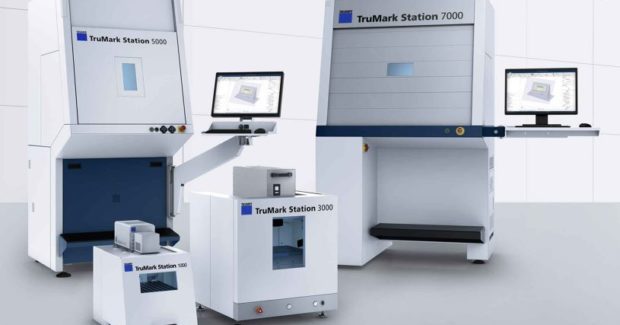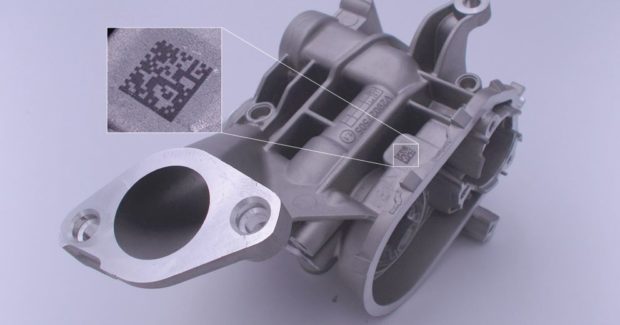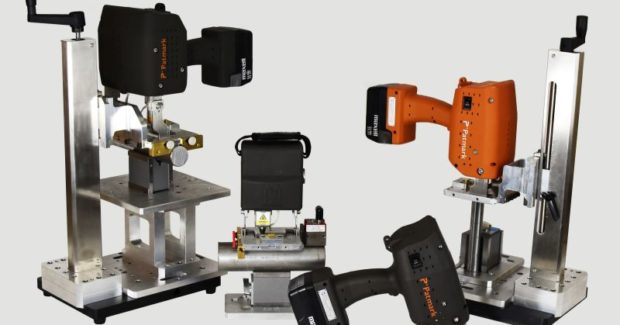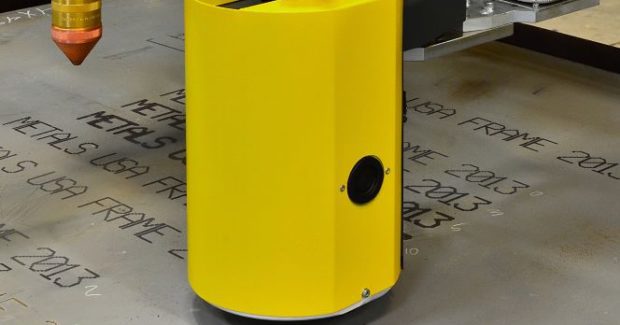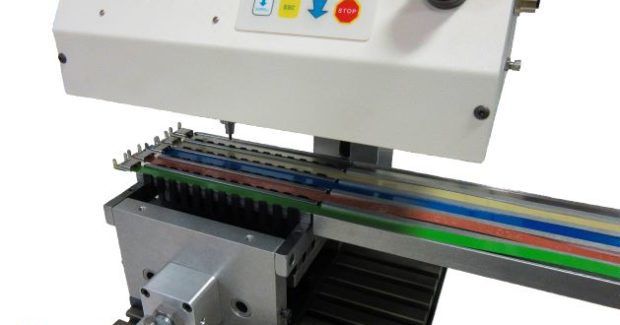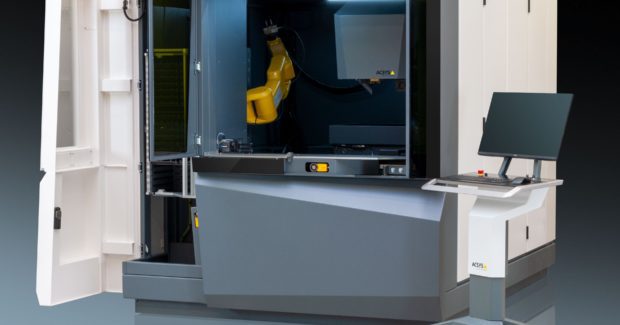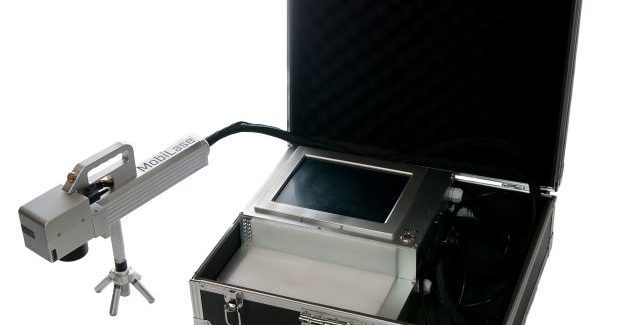“X” Marks the Spot
Discover the latest advances in marking systems.
Posted: July 8, 2021
Fabricators are increasingly incorporating marking solutions into their production processes, whether for traceability of products in the automotive or aerospace sectors, for example. Or in the production process itself, marking components to identify them for assembly and then covering the marks on the finished product with paint, for instance. For some manufacturers, they require their marking systems to leave visible marks after coating is completed. Identification lowers the chance of costly mistakes and wasting valuable production time.
Marking systems range from portable options to machines with small footprints that can fit into tight spaces. Read on to learn about product options that would best suit your machine shop.
VARIETY OF SIZES AND POWER CLASSES PROVIDE THE OPTIMAL DEVICE FOR EVERY MARKING TASK
TRUMPF Inc.’s (Farmington, CT) marking lasers are characterized by excellent marking quality and product reliability. The TruMark family of products are available in various power levels in three different wavelengths, which allows a broad range of materials to be processed. OEM laser or turnkey packages including a marking system, beam source, and data processing solution, are available.
Products include the TruMark Station 5000 marking system, which is well-suited to laser marking of average and large lot sizes and components. It provides many options for simple operation and for a wide variety of workpieces. The comprehensive accessories enable you to configure the machine for your tasks.
The TruMark Station 7000 has the largest work area of all TRUMPF marking workstations. It is ideal for automated batch production and large lot sizes. Individual large and heavy parts can be accommodated inside the station, as can many small components that need to be processed on pallets.
www.trumpf.com/en_US/products/lasers/marking-lasers/
UNIQUE MARK: PICOSECOND LASER MARKING IS RESISTANT TO CORROSION
Amada Weld Tech Inc. (Monrovia, CA) now offers black, corrosion-resistant marking capability for the medical device manufacturing industry. This unique mark, frequently used for stainless steel implantable devices and surgical tools (e.g., banding around trocars or UDI marking on surgical scalpels) survives multiple passivation and autoclaving cycles.
This black mark is generated using a picosecond laser. The ultrashort pulse durations of the picosecond laser allow it to impart energy to a material surface with almost no thermal effect. Unlike the heat-generated annealed marks made with fiber lasers, marks created by picosecond IR lasers are extremely high contrast periodic nanostructures with antireflective properties that make the marks appear deep black against their surroundings. The marks are restructured surface material rather than an oxide layer, making them resistant to bacterial growth, passivation, corrosion and autoclaving. What’s more, the processing window for developing the marks on stainless steels, aluminum and titanium is wider than that of traditional fiber lasers. Picosecond lasers also offer marking capabilities on polymers often used in medical devices.
The picosecond laser is integrated into bespoke CDRH Class 1 systems that are designed for a specific part or range of parts. System features may include a galvo scanning head, a bar code scanner for job load, four or more axes of motion, and machine vision for part recognition and mark placement.
MARKING ON ALUMINUM IS COMPANY’S SPECIALTY
Aluminum is used in a large sector of activity, particularly in aeronautics and shipbuilding, the electrical and electronics industry, and is particularly appreciated in the automotive industry. Many auto manufacturers and equipment suppliers use aluminum for the manufacture of car chassis, steering columns and power steering components. It is also found in the manufacture of turbo bodies, engine crankcases, cooler or automatic air conditioning elements. Aluminum is also important in the expanding new energy vehicle category, particularly in the manufacture of battery casings and other electronic components.
Just as the use of aluminum varies, so do traceability requirements such as barcode, data matrix, alphanumeric or logo marking. In addition, there are several constraints linked to the nature of the aluminum (anodized, alloy, etc.) as well as a customer’s requirements, particularly in terms of marking contrast or depth. Some want the marking to be visible after the applications of coatings or of resisting surface treatments, such as shot peening.
SIC Marking USA’s (Pittsburgh, PA) laser product range is particularly suitable for marking aluminum components both in series and individually. The line consists of lasers that can be integrated with various options, including:
- 3D function for marking on complex shaped parts
- Vision function for fast and reliable barcodes and data matrix reading
- Rotary axis for cylindrical parts marking
The range is completed by three stations (L-BOX, XL-BOX and XXL-BOX) allowing for a dedicated marking station. This can be integrated into a production line or used as a stand-alone marking station. Small, medium and even large production runs are possible. The resizing of the boxes, the creation of specific tooling, the addition of additional movements (Z axis, rotary axis) are options available on request.
SIC Marking is a world leader in industrial traceability and for more than 30 years has provided marking solutions to meet industry challenges associated with identifying aluminum components. For example, the company recently worked with a major German equipment manufacturer to meet its requirements, which were to mark a 7-by-7 mm DMC code on air conditioning compressor pistons to facilitate their internal traceability. These codes needed to be marked deep enough to allow proofreading even after shot peening and tinning. All this in reduced cycle times. After various marking tests carried out by SIC’s team, the chosen solution was a 50W fiber laser, its power enabling it to carry out deep marking in record time.
NEW PORTABLE QUICK-CHANGE FIXTURES AND BENCH TOP QUICK CHANGE BASE PLATES MAKE VERSATILE PIN MAKERS
Marking information on incoming raw material and outgoing finished parts requires human read characters, scannable 2D data matrix or in some cases both. With target mark areas in many cases very limited, MarkinBOX and Patmark pin markers can pin mark legible characters as small as 1 mm high, and 2D data matrix marking as small as 4 mm square has been done on 304ss.
The portability of the pin marker can be of great benefit particularly in material receiving areas and when it is more practical for marking of parts in place rather than processing under a bench top stand. MB Metal Technologies (Milwaukee, WI) accepted the challenge of making the MarkinBOX and Patmark portable pin marking products very versatile for customers. Is it a portable or is it a bench top? It can be both.
Quick-change fixtures with adjustable jaws that locate the MarkinBOX and Patmark portable markers on round, square, rectangular material for face marking can also be used with adjustable discs for end of bar marking. That is where the story began, addressing customer needs. It did not stop there, as customers based on quantities involved also indicated there would be instances that mounting the MarkinBOX or Patmark portables to a bench top stand would be optimum, allowing machine operators to also do the part marking after CNC machines completed their cycle. Productivity in both making and marking finished parts.
MarkinBOX and Patmark portable pin markers using standard quick-change fixtures will register the marker to the raw material or the part for accurate marking. In cases where the use of a bench top stand with the pin marker makes sense, the new bench top quick change base plate allows the portable MarkinBOX and Patmark units to be quickly attached to the bench top using a spring-loaded detent, which firmly attaches the marker.
Easy on and easy off a bench top stand makes MarkinBOX or Patmark portable pin markers a very versatile tool.
NEW INKJET MARKING SYSTEM FOR IMPROVED PART ACCURACY, QUALITY AND SAFETY
ESAB Welding & Cutting Products (Annapolis Junction, MD) offers an inkjet plate marking tool, an option for any ESAB cutting automation system. With options that include fixed or rotating heads, as well as drop-on-demand (DOD) or continuous inkjet (CIJ) technology, the inkjet station is ideal for steel service centers, shipyards and manufacturers that require traceability of their parts within the production environment. Inkjet marking especially appeals to manufacturers who want to identify parts during assembly but then want to shot blast or paint over the marks on the finished product.
“Adding an inkjet marking station to an automated cutting table reduces cycle time because the system can mark parts much faster, with less error and in much greater detail than a human operator working by hand,” said Steve Zlotnicki, ESAB Cutting Systems’ Global Product Manager. “Automated marking also eliminates the potential hazard of operators climbing on the table or trying to mark parts while the system is cutting.”
ESAB offers two types of inkjet technology. DOD prints characters up to 67 mm tall for greater visibility. CIJ uses dual-nozzle technology for the higher definition required by bar codes, QR codes or data matrix codes. CIJ can print characters up to 20 mm tall. Both types of systems can be used for marking either text or layout lines, and text can be oriented in any direction using an automatic rotation system.
NEW MARKING FIXTURE PERMANENTLY MARKS HOSE BANDS FIVE AT A TIME
Kwik Mark Inc.’s (McHenry, IL) Band Marking Fixture, which is made in the USA, provides a solution for permanently marking your hose bands five at a time, with alphanumeric, serial numbers, date codes and graphics. Variable data from external files may also be marked.
This design features five rows of clamping with 12 “fingers” on each row that flex and conform to part dimensional variations as well. One toggle lever clamps all five bands and draws them down securely for the dot peen marking operation. Custom configurations and pneumatic powered designs are also available. The marker display includes a batch counter, cycle timer, current status, production history log, and percentage of completion information.
FULLY AUTOMATIVE MULTISHIFT LASER PROCESSING SYSTEM
ACSYS Lasertechnik’s (Lenexa, KS) Multishift is a fully automatic laser system with Industry 4.0 integration. It offers some of the most advanced laser marking, structuring, cutting and engraving on the market, suitable for applications in automotive and tooling industries, among others. Specialized sensitive robotic gripping leaves no indelible marks. Multishift features automatic pallet processing to enable faster and more accurate laser processing as well as eliminating some batch tasks.
The product also features optical character recognition and optical parts recognition, which provides complete, accurate, and hands-free laser processing capabilities, which saves time and minimizes product reworks. The system’s online depth control provides optimal engraving, and dynamic focus control tracks the laser’s focal point, delivering perfect laser accuracy.
The Multishift features the most sophisticated and precise industrial lasers on the market, supporting nanosecond, picosecond, femtosecond, and CO2 laser processing capabilities to provide operators with progressively finer laser structuring options. Engraving in 3D is also supported.
Designed to be user-friendly, the laser system features an industrial-grade frame made of high-strength steel with a temperature-stable granite structure. Glass doors provide 360-degree access to laser process functions. Its minimized footprint and configurable design means it fits in smaller spaces, and it can be configured to a company’s specifications. This laser system is height-adjustable, features a touch-sensitive surface, and a high-resolution camera that does not require reconfiguring for each laser session.
PORTABLE FIBER LASER MARKING SOLUTION IN A SUITCASE
Rocklin Manufacturing Co. (Sioux City, IA) introduces MobiLase, an all-in-one industrial fiber laser marking unit housed in a 45-pound rolling suitcase. Its unique portability enables laser marking to be completed anywhere in a facility, as opposed to the typical heavy, stationary laser marking setup. With MobiLase, laser marking can take place directly at the part instead of lugging parts to a laser marking station. This innovation eliminates costly downtime and investments in elaborate contraptions to mark large parts. The marking unit features a 30-watt fiber laser and a large, 100-by-100 mm marking window, delivering fast and durable laser markings on nearly any material ranging from plastics to steel to precious metals, among many others. The seven-pound handheld applicator is equipped with a trigger to start marking plus two bracket options for ease of marking various part shapes. These brackets also enable rapid focusing from a consistent, repeatable distance, which is further optimized by the laser pointer simulator.
The MobiLase features a touchscreen PC embedded in the suitcase, which enables a wide range of easily programmable and potentially intricate markings, including:
- Numbers, letters and characters
- Time and date
- Barcodes, 2D codes and QR codes
- Images, logos, symbols and more
ANCA’S NEW AUTOMARKX WORKS SEAMLESSLY WITH GRINDERS TO AUTOMATE TOOL MARKING PROCESS
The AutoMarkX is ANCA’s (Melbourne, Australia) tool marking solution designed particularly for the needs of cutting tool production. ANCA offers critical tool grinding processes; CPX for blank preparation, and tool grinding on the company’s TX, MX and FX tool and cutter grinders. AutoMarkX works with ANCA CNC grinders and automates the tool marking process, further extending unmanned production operations. It is capable of automated pallet loading and takes care of the tool laser marking process, freeing up operators to perform more value-adding tasks.
This marking solution is also designed for integration with AIMS, being able to automatically receive and dispatch pallets from AutoFetch, while connectivity to the AIMS server provides details of the message to be marked on the tools. (The first-to-market ANCA Integrated Manufacturing System (AIMS) uses smart automation and IT integration to connect tool production processes and systems.)
Product Manager, Jan Irzyk said: “This machine is efficient and compact but more than that, it can be integrated with your ERP and AIMS, so that technology can work together. Removing the need for manual handling, our new laser marking solution pushes tool marking capabilities into lights-out production.”

